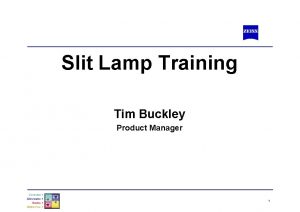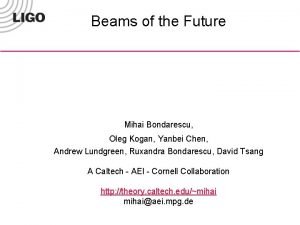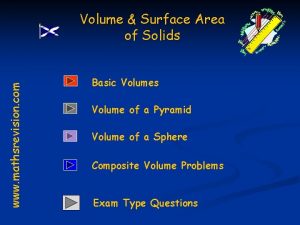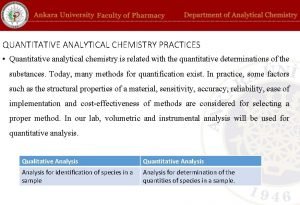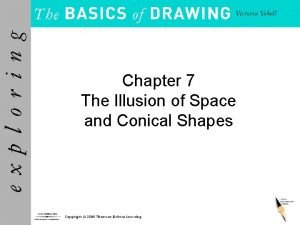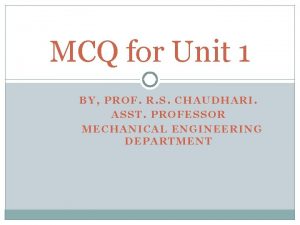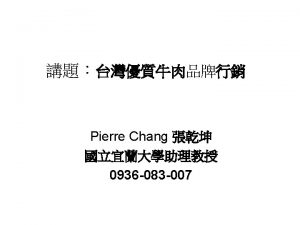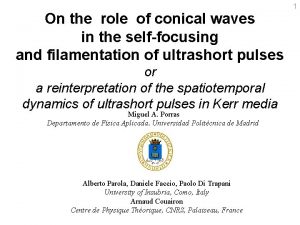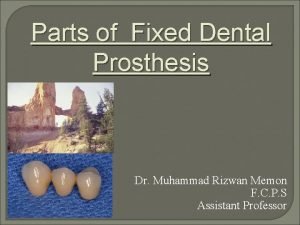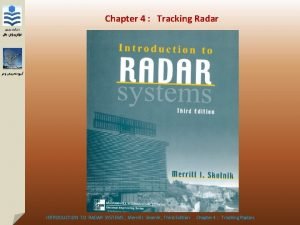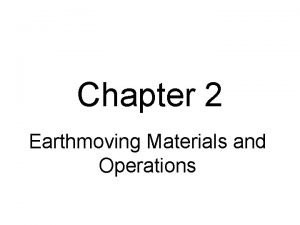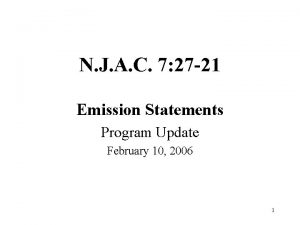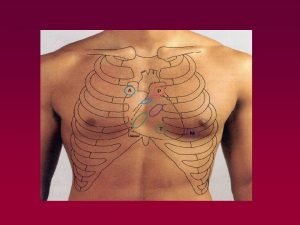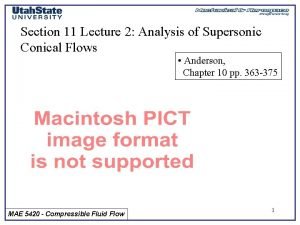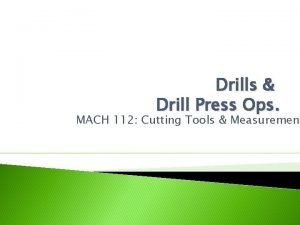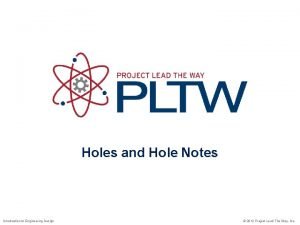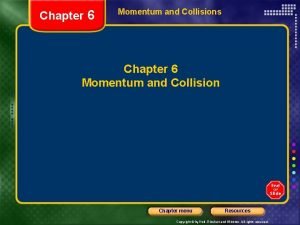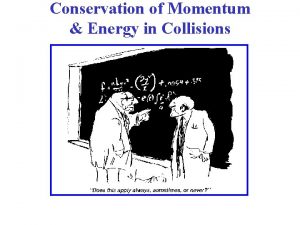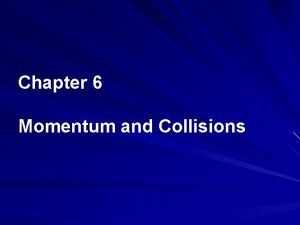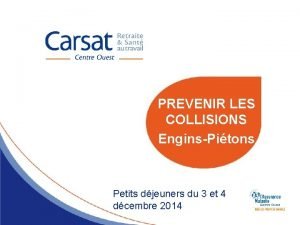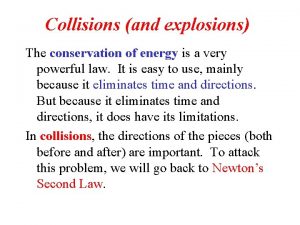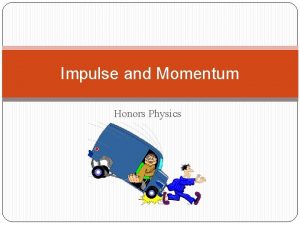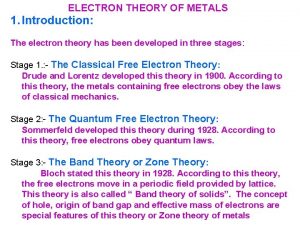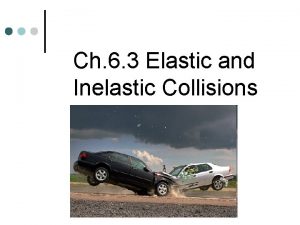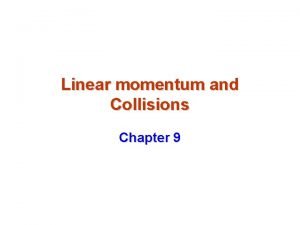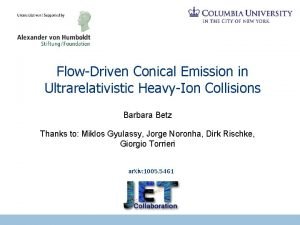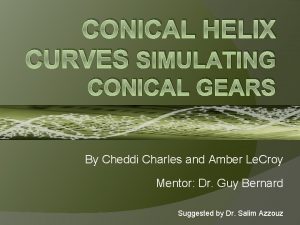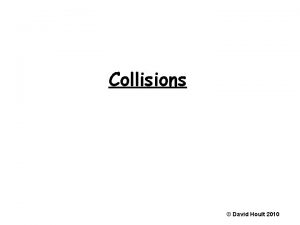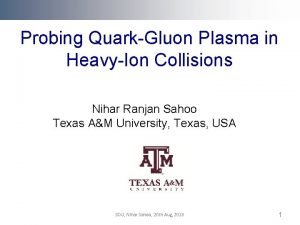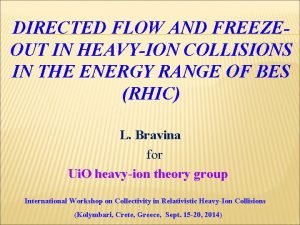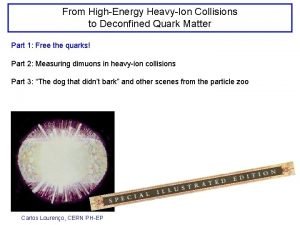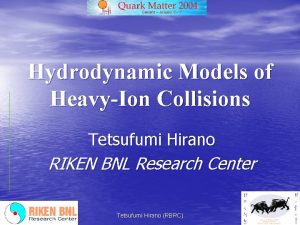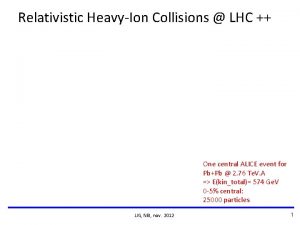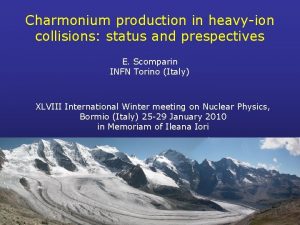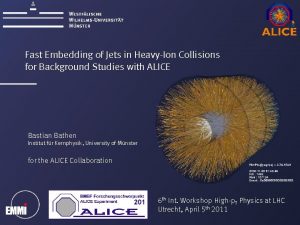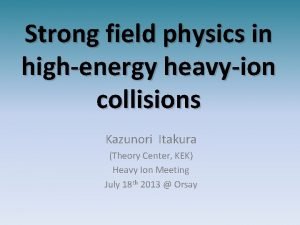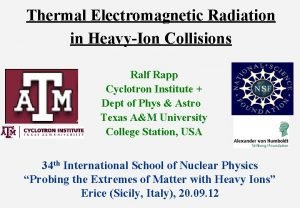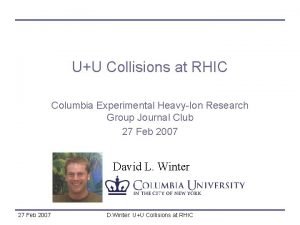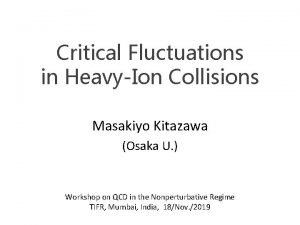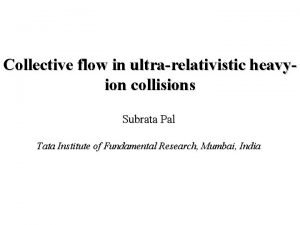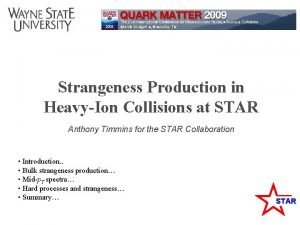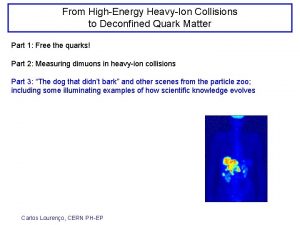Conical Emission in HeavyIon Collisions Jason Glyndwr Ulery

































- Slides: 33

Conical Emission in Heavy-Ion Collisions Jason Glyndwr Ulery Purdue University 8 February 2008 Quark Matter 2008 8 February 2008 Jason Glyndwr Ulery - Purdue University Quark

Outline • Motivation • Theory • Mach-cone shock waves • Čerenkov gluon radiation • Experiment • PHENIX • STAR • CERES • Summary • Future 8 February 2008 Jason Glyndwr Ulery - Purdue University Quark Matter 2008 2

Motivation STAR PRL 95 152301 Ulery QM 05 • Mach-cone in HIC first introduced in 1970 s by Hofmann, Stöcker, Heinz, Scheid and Greiner. • Away-side structure in 2 -particle correlations renewed interest. • Conical emission is a possible explanation for shape: • Mach-cone shock waves • Čerenkov gluon radiation • Other explanations suggested: • Large angle gluon radiation • Defected jets Au+Au PHENIX PRL 97 052301 0 /2 CERES Pb+Au 0 -5% Kniege QM 06 • deflected by radial flow • path-length dependent energy loss 8 February 2008 Jason Glyndwr Ulery - Purdue University Quark Matter 2008 3

Conical Emission • Mach-cone: • Shock waves excited by a supersonic parton. • Can be produced in different theories: • Hydrodynamics • H. Stöcker et al. (Nucl. Phys. A 750: 121, 2005) • J. Casalderra-Solana et. al. (Nucl. Phys. A 774: 577, 2006) • T. Renk & J. Ruppert (Phys. Rev. C 73: 011901, (2006)) • Colored plasma • J. Ruppert & B. Müller (Phys. Lett. B 618: 123, 2005) • Ad. S/CFT • S. Gubser, S. Pufu, A. Yarom. (ar. Xiv: 0706. 4307 v 1, 2007) • Čerenkov Gluon Radiation: • Radiation of gluons by a superluminal parton. • I. M. Dremin (Nucl. Phys. A 750: 233, 2006) • V. Koch et. al. (Phys. Re. V. Lett. 96, 172302, 2006) • Parton Cascade • G. L. Ma et. al. (Phys. Lett. B 647, 122, 2007) 8 February 2008 Jason Glyndwr Ulery - Purdue University References are only a small subset of those existing. Apologies to those not included. Quark Matter 2008 4

Čerenkov Gluon Radiation • Gluons radiated by superluminal partons. • Angle is dependent on emitted momentum. Čerenkov angle vs emitted particle momentum Koch, Majumder, Wang PRL 96 172302 (2006) p (Ge. V/c) 8 February 2008 Jason Glyndwr Ulery - Purdue University Quark Matter 2008 5

Mach-Cone Trigger M Away-side • Mach angle depends on speed of sound in medium PNJL Model • T dependent • Angle independent of associated p. T. Mikherjee, Mustafa, Ray Phys. Rev. D 75 (2007) 094015 8 February 2008 Jason Glyndwr Ulery - Purdue University Quark Matter 2008 6

Hydrodynamic Mach-Cone Cloud formed by a plane breaking the sound barrier. • Energy radiated from the parton is deposited in collective hydrodynamic modes. • Strength of the correlation dependent on source term which is not fundamentally derived. • Similar to jet creating a sonic boom in air. Betz QM 08 Talks by B. Betz and B. Müller Session XIII 8 February 2008 Jason Glyndwr Ulery - Purdue University Quark Matter 2008 7

Colored Modes Perpendicular • Colored sound. • Černkov gluon radiation is the transverse mode excited by superluminal parton in the plasma. Current Density • QCD analog of charged particle in plasma from QED. • Mach-cone is longitudinal modes excited in quantum plasma by a supersonic parton. Parallel J. Ruppert & B. Müller, Phys. Lett. B 618 (2005) 123 8 February 2008 Jason Glyndwr Ulery - Purdue University Quark Matter 2008 8

Ads/CFT Poynting Vector • Mach cone with strong diffusion wake from heavy quarks. • Mach cone with no diffusion wake for quarkonium. • No need to add a source term. diffusion wake • Done is infinitely massive limit. Talk by Noronha Session IV 8 February 2008 Jason Glyndwr Ulery - Purdue University Gubser, Pufu, Yarom ar. Xiv: 0706. 4307 v 1 (2007) Bullet at 2. 45 cs shock-wave Quark Matter 2008 9

Azimuthal 3 -Particle Correlations near Medium away deflected jets away near di-jets Medium away Conical Emission 8 February 2008 Jason Glyndwr Ulery - Purdue University Quark Matter 2008 10

Parton Cascade • Simulated data analyzed from AMPT parton cascade model. • Backgrounds subtracted through event mixing in similar method to real data. • Conical emission signal seen. • What is the mechanism that produces the signal? 8 February 2008 G. L. Ma QM 06 background subtracted 3 -particle correlation signal Jason Glyndwr Ulery - Purdue University Quark Matter 2008 11

Mach-Cone and Flow Renk, Ruppert, Phys. Lett. B 646 19 (2007) • Rapidity distribution and longitudinal flow affects the observed angle and width. • Transverse flow affects shape of 3 -particle correlation. • signal at ~1 Ge. V/c ~9 x larger if flow and shockwave aligned than if perpendicular. 8 February 2008 Renk, Ruppert, Phys. Rev. C 76, 014908 (2007) Jason Glyndwr Ulery - Purdue University Quark Matter 2008 12

Detectors PHENIX at RHIC STAR at RHIC CERES at SPS • PHENIX has 2 900 wedges in azimuth. • STAR and CERES have full 3600 azimuthal acceptance. 8 February 2008 Jason Glyndwr Ulery - Purdue University Quark Matter 2008 13

Poster 243 Ajitanand PHENIX Analysis Au+Au 10 -20 % Ajitanand HP 06, IWCF’ 06 Trigger Near-Side Near Side * * * *= * Plane Normal to Trigger Away Side • Polar coordinate system relative to trigger particle direction. • Natural coordinate system if jets are back-to-back in both and . • * is angle from trigger. • * the angle between the two associated particles projected onto plane defined by trigger. • 2. 5<p. TTrig<4 Ge. V/c • 1<p. TAssoc<2. 5 Ge. V/c 8 February 2008 Jason Glyndwr Ulery - Purdue University Quark Matter 2008 14

Poster 243 Ajitanand PHENIX Simulations Simulated Deflected jet Ajitanand HP 06, IWCF’ 06 Simulated Mach Cone *=0 * 8 February 2008 Simulations with PHENIX acceptance. * Jason Glyndwr Ulery - Purdue University Quark Matter 2008 15

Poster 243 Ajitanand PHENIX Results * Projections v 2 subtracted Ajitanand HP 06, IWCF’ 06 v 2 subtracted Au+Au 10 -20% 2 -particle dominated v 2 and 2 -particle subtracted Deflected Mach-cone • Shape consistent with simulated mach-cone. • 3 -particle/2 -particle ~ 1/3, very large • Residual background? 8 February 2008 Jason Glyndwr Ulery - Purdue University PHENIX PRL 97, 052301 (2006) Quark Matter 2008 16

Poster: 36 Ma STAR Raw Ulery QM 05, QM 06 (poster) 2 -Particle Hard-Soft • In - space. • 3<p. TTrig<4 Ge. V/c and 1<p. TAssoc<2 Ge. V/c (except as noted) • 2 -Particle background normalized such that background subtracted 3 -particle signal is ZYAM. • Hard-soft background removes instances where 1 associated particle is correlated with trigger. 8 February 2008 Jason Glyndwr Ulery - Purdue University Quark Matter 2008 17

Poster: 36 Ma STAR Soft-Soft Ulery QM 05, QM 06 (poster) v 2(T) v 2(1, 2) v 4(T) v 4(1, 2) +v 2(T, 1, 2)v 2(1, 2, T) v 4(2, T, 1) • Soft-soft is the background from both associated particles independent of the trigger. • Background from the correlations of trigger and associated particles to reaction-plane are added from flow measurements. 8 February 2008 Jason Glyndwr Ulery - Purdue University Quark Matter 2008 18

Poster: 36 Ma Ulery QM 05, QM 06 (poster) STAR Results pp Au+Au 50 -80% 8 February 2008 d+Au Au+Au 10 -30% Jason Glyndwr Ulery - Purdue University Cu+Cu 0 -10% Au+Au 0 -12% Quark Matter 2008 19

STAR Projections and Angle ZDC 0 -12% Au+Au shows significant peaks in off-diagonal projection at: 1. 38 ± 0. 02 (stat. ) ± 0. 06 (sys. ) radians Talk: Mohanty Ulery QM 05, QM 06 (poster) Conical emission peaks 8 February 2008 Jason Glyndwr Ulery - Purdue University Quark Matter 2008 20

Poster: 36 Ma STAR Associated PT Dependence 0. 5<p. TAssoc<0. 75 1<p. TAssoc<1. 5 2<p. TAssoc<3 • No significant p. T dependence of observed emission angle. • Consistent with Mach-cone • Inconsistent with simple Čerenkov radiation Ulery QM 05, QM 06 (poster) Poster: P 36 Ma 8 February 2008 Jason Glyndwr Ulery - Purdue University Quark Matter 2008 21

Poster 251 Appelshaeuser, Kniege, Plokson CERES Kniege QM 06, ISMD 07 Trigger Flow (v 2 v 2) preliminary Soft-Soft preliminary Hard-Soft preliminary Raw • 2. 5<p. TTrig<4. 0 Ge. V/c • 1. 0<p. TAssoc<2. 5 Ge. V/c • Background subtraction method similar to STAR. • axis ranges are different from STAR 8 February 2008 Jason Glyndwr Ulery - Purdue University Quark Matter 2008 22

CERES Results Kniege QM 06, ISMD 07 h++ and h-- preliminary h+- and h-+ preliminary hhh Poster 251 Appelshaeuser, Kniege, Plokson • Conical emission peaks are seen. 8 February 2008 Jason Glyndwr Ulery - Purdue University Quark Matter 2008 23

Summary • Broadened and double-peaked away-side structure in 2 -particle correlations. • Can be explained by conical emission or other physics mechanisms. • Mach-cone • Čerenkov gluon radion • PHENIX • shape consistent with Mach-cone simulation. • residual background? • STAR • Evidence of conical emission of correlated hadrons at an observed angle of 1. 38 radians • p. T independence of the angle suggests Mach-cone emission • CERES • peaks consistent with conical emission • With the aid of theoretical models the extracted angle my provide information on the speed of sound of the medium and the equation of state. 8 February 2008 Jason Glyndwr Ulery - Purdue University Quark Matter 2008 24

Future Prospects • New data and detectors will allow for: • Higher statistics will allow for systematic studies of both trigger and associated p. T. • Helped by increased jet production at LHC • Identified particle results: • Mach-cone emission should have a mass dependence in correlation strength • Full azimuthal TOF detectors ALICE and STAR (upgrade) will provide good PID for these analyses. • Possible change in angle between SPS, RHIC, and LHC. • Different initial temperatures • Many theoretical investigations have been carried out. • More work is needed to understand what the data tells us about cs and EOS. 8 February 2008 Jason Glyndwr Ulery - Purdue University Quark Matter 2008 25

Parallel Session xiii • Medium Response to Jets & Mach Cone 8 February 2008 Jason Glyndwr Ulery - Purdue University Quark Matter 2008 26

8 February 2008 Jason Glyndwr Ulery - Purdue University Quark Matter 2008 27

Backup 8 February 2008 Jason Glyndwr Ulery - Purdue University Quark Matter 2008 28

Centrality Dependence 8 February 2008 Jason Glyndwr Ulery - Purdue University Quark Matter 2008 29

Pruneau (STAR) QM’ 06 STAR Cumulant C 3( 12, 13) = 3( 12, 13) - 2( 12) 1( 3) – 2( 13) 1( 2) - 2( 12 - 13) 1( 1) - 2 1( 1) 1( 2) 1( 3) • • • Done in - space where = Trigger- Associated Trigger particles of 3<p. T<4 Ge. V/c. Associated particles of 1<p. T<2 Ge. V/c. Mathematically Defined. Measures all three-particle correlations. 8 February 2008 Jason Glyndwr Ulery - Purdue University Quark Matter 2008 30

STAR Cumulant Results Au+Au 50 -80% Au+Au 10 -30% Au+Au 0 -10% Pruneau (STAR) QM’ 06 • • Non-zero 3 -particle correlation. Results contain all possible 3 -particle correlations; jet, flow and jet flow. Further interpretation requires model assumptions. Non-Poisson fluctuations can leave residual 2 -particle correlations. 8 February 2008 Jason Glyndwr Ulery - Purdue University Quark Matter 2008 31

STAR With Identified Associated • Comparison of correlation with identified proton and pion associated. • Hint of wider peaks for h-pp. 8 February 2008 Jason Glyndwr Ulery - Purdue University Poster: 36 Ma 2. 5<p. TTrig<10 Ge. V/c 0. 7<p. TAssoc<1. 4 Ge. V/c Quark Matter 2008 32

Cone Signal • 1. 2 pairs/trigger in 3 -particle off-diagonal strength ~0. 6 (off-diagonal)x 4 (peaks)x(0. 7 x 0. 7) • 0. 7 particles/trigger ~0. 5 (away-side)x 2(peaks)x 0. 7 • (0. 7 )2=1. 2 (assume Poison distribution) • ~40% (% of triggers with a cone in the acceptance). • ~2~(0. 7/0. 4) cone particles per event with cone in acceptance. 8 February 2008 Jason Glyndwr Ulery - Purdue University Quark Matter 2008 33
 3 mirror contact lens
3 mirror contact lens Mihai bondarescu
Mihai bondarescu Cone volume formula
Cone volume formula Conical dlask
Conical dlask Music instruments drawing
Music instruments drawing Illusion of space
Illusion of space For flat pivot bearing the rate of wearing
For flat pivot bearing the rate of wearing Beef conical muscle 中文
Beef conical muscle 中文 Conical wave
Conical wave Saddle pontic
Saddle pontic Conical scan tracking radar block diagram
Conical scan tracking radar block diagram Conical spoil pile
Conical spoil pile Conical breast shape
Conical breast shape Zero voc conical
Zero voc conical Fibroserous sac that encloses the heart
Fibroserous sac that encloses the heart Conical flow
Conical flow Spinal cord
Spinal cord Mach drills
Mach drills Pontic retainer
Pontic retainer A hot air balloon rising straight up from a level field
A hot air balloon rising straight up from a level field Egyptian flower arrangements
Egyptian flower arrangements Hole symbols engineering
Hole symbols engineering Perfectly elastic collision
Perfectly elastic collision Chapter 6 momentum and collisions
Chapter 6 momentum and collisions When you move into the deceleration lane, you should
When you move into the deceleration lane, you should Does an elastic collision conserve momentum
Does an elastic collision conserve momentum Momentum and collisions
Momentum and collisions Prévention des collisions engins-piétons
Prévention des collisions engins-piétons Collisions and explosions
Collisions and explosions Physics collision
Physics collision Drawbacks of free electron theory
Drawbacks of free electron theory Elastic vs inelastic
Elastic vs inelastic Elastic potential energy real world examples
Elastic potential energy real world examples Energy loss formula
Energy loss formula
